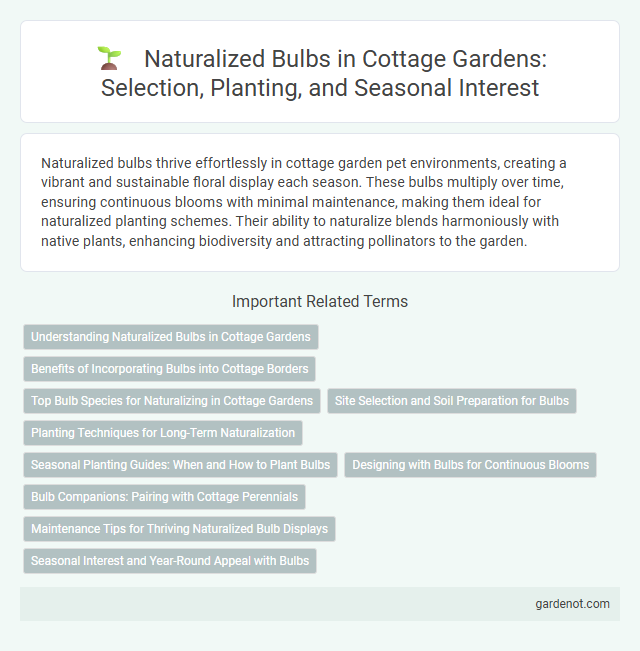Naturalized bulbs thrive effortlessly in cottage garden pet environments, creating a vibrant and sustainable floral display each season. These bulbs multiply over time, ensuring continuous blooms with minimal maintenance, making them ideal for naturalized planting schemes. Their ability to naturalize blends harmoniously with native plants, enhancing biodiversity and attracting pollinators to the garden.
Understanding Naturalized Bulbs in Cottage Gardens
Naturalized bulbs such as daffodils, crocuses, and snowdrops thrive in cottage gardens by multiplying over time, creating a natural and effortless spring display. These bulbs adapt to local conditions, requiring minimal maintenance while enhancing biodiversity and soil health. Planting naturalized bulbs in drifts or clusters mimics wild growth, contributing to the charming, informal aesthetic characteristic of cottage garden design.
Benefits of Incorporating Bulbs into Cottage Borders
Incorporating naturalized bulbs into cottage garden borders enhances seasonal interest by providing vibrant, early blooms that attract pollinators such as bees and butterflies. These bulbs require minimal maintenance and multiply over time, creating a dense, natural look that complements the informal style of cottage gardens. Their adaptability to various soil types and excellent naturalizing capability ensure long-lasting visual appeal and biodiversity within the garden ecosystem.
Top Bulb Species for Naturalizing in Cottage Gardens
Naturalized bulbs such as daffodils (Narcissus), snowdrops (Galanthus), and bluebells (Hyacinthoides non-scripta) thrive in cottage gardens due to their ability to multiply and spread naturally over time. These species offer prolonged blooming periods, low maintenance requirements, and adaptability to various soil types, enhancing the informal, lush aesthetic characteristic of cottage gardens. Their naturalizing habit supports biodiversity by providing early spring nectar sources for pollinators within the garden ecosystem.
Site Selection and Soil Preparation for Bulbs
Naturalized bulbs thrive in well-drained soil with moderate fertility and slightly acidic to neutral pH levels, making site selection crucial for healthy growth. Choose a location that receives full to partial sunlight, ensuring the soil remains moist but not waterlogged to prevent bulb rot. Incorporate organic matter such as compost or well-rotted manure during soil preparation to improve drainage and nutrient availability for optimal bulb establishment.
Planting Techniques for Long-Term Naturalization
Plant naturalized bulbs in well-drained soil at a depth two to three times their height to ensure strong root development and sustained growth. Group bulbs in clusters of six or more to mimic natural spreading patterns and encourage long-term proliferation in cottage gardens. Mulching with organic material maintains moisture and temperature consistency, enhancing bulb survival through seasonal changes.
Seasonal Planting Guides: When and How to Plant Bulbs
Naturalized bulbs thrive when planted in the fall, ideally 6-8 weeks before the first hard frost, allowing roots to establish before winter dormancy. Select well-drained soil in sunny to partially shaded spots and plant bulbs at a depth two to three times their height, spacing them according to species recommendations for naturalized growth. Regular watering after planting encourages root development, while mulch protects bulbs through colder months and supports vibrant spring blooms.
Designing with Bulbs for Continuous Blooms
Naturalized bulbs such as daffodils, crocuses, and snowdrops create vibrant, low-maintenance displays that enhance cottage garden charm through naturalized drifts. Selecting a variety of species with staggered bloom times ensures continuous color from early spring to late summer. Planting bulbs in clusters among perennials and grasses promotes a seamless transition and sustained visual interest throughout the growing season.
Bulb Companions: Pairing with Cottage Perennials
Naturalized bulbs such as daffodils, crocuses, and snowdrops thrive alongside cottage perennials like foxgloves, delphiniums, and peonies, creating layered blooms throughout spring and early summer. Combining these bulbs with perennials enhances seasonal diversity and supports a sustainable garden ecosystem by attracting pollinators such as bees and butterflies. Strategically planting bulbs near shade-tolerant perennials ensures prolonged garden interest and naturalized growth patterns ideal for a classic cottage garden aesthetic.
Maintenance Tips for Thriving Naturalized Bulb Displays
To maintain thriving naturalized bulb displays in a cottage garden, ensure bulbs are planted in well-drained soil with adequate organic matter to prevent rot and encourage healthy growth. Water bulbs deeply during dry spells but avoid overwatering, as excess moisture can lead to fungal diseases. After blooming, allow foliage to die back naturally to replenish bulb nutrients for the following season, and consider mulching with compost to enhance soil fertility and moisture retention.
Seasonal Interest and Year-Round Appeal with Bulbs
Naturalized bulbs such as daffodils, crocuses, and snowdrops provide vibrant seasonal interest in cottage gardens by blooming from early spring through late summer. Their ability to multiply and spread naturally ensures a continuous display of color and texture, enhancing year-round appeal without extensive maintenance. Incorporating a variety of bulbs with staggered bloom times creates dynamic garden layers that attract pollinators throughout the growing season.
Naturalized bulb Infographic

 gardenot.com
gardenot.com